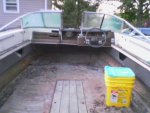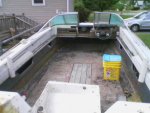Re: My Floor on a Sea Ray 1972 Pics
Decisions, decisions..
If the gap is small 1/2 inch to less than 1 inch, I might be inclined to grind down the area and make some chopped fiber reinforced filler
http://www.shareaproject.com/pages/imageDetail,p,148,i,2869,00.html
and fill in around the edges. Grind down the top surface of the existing glass with 36 grit paper and add a couple of layers of glass over the existing. You probably also want to tape over the edges that you fixed first.
I don't agree with Tashadaddy (sorry man - we all have opinions you know) that the different orientation of the plywood will affect whether its spongy or not. As a carpenter all sheet materials are designed to have nearly equal strength in either direction.. That's why the direction of the grain in each layer of the plywood runs at different angles.
The plywood in my boat runs front to back and the floor is not spongy. It is more important that the joints and edges of the plywood are over something solid. Every joint should be over a stringer or a frame..
I apparently didn't take pictures of the framing I used to join the floor panels on my job, but here is the explanation:
http://www.shareaproject.com/pages/imageDetail,p,148,i,3424,00.html
Also you can slightly extend the size of a plywood panel, if you do it right..
http://www.shareaproject.com/pages/imageDetail,p,148,i,2766,00.html
Keep in mind all of the layers of plywood are held together with glue, and every available modern wood glue is actually stronger that the wood itself, if used properly according to directions.
Watch Norm Abrahm's (The New Yankee workshop
http://www.newyankee.com/index.shtml), he uses glues correctly. He always applies wood glue to BOTH sides of the joint before assembling.. You need to do that wet out the wood on both sides. And, don't over clamp the joint, you will literally squeeze all of the glue out of the joint and there won't be any glue left in the joint. Folks that crank their clamps down as tight as they can are asking for joint failures. Your clamps are there to hold the materials in position until the adhesive in the joint sets up, and thats all.
Oh, and gluing MDF, which you would not use in a boat, is unusual because is soaks up glue like a sponge. You have to pre-treat the edge with glue, let it dry and then apply a 2nd layer and assemble.
Sorry - the carpenter will now get off the soap box..





















